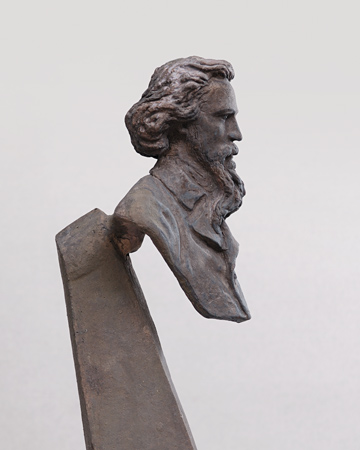 |
|
|
| Articles by Other
Authors |
|
|
|
| |
|
Commentary on the Model Monument
of Russian Philosopher Vladimir Solovyov
Extracts |
| |
How can one render in sculpture the soul, spirit, and body of a great Russian thinker, whose creative work has honoured him in Russian philosophical science with "a monument wrought not by human hand?" How is it possible to express it in stone or in metal, to make an imprint of an out-of-the-ordinary intellect which presented itself in such a contradictory a manner before other people's eyes – contained in the philosopher's living body that was infinitely more plastic than stone or metal? Which episode in the short temporal creative evolution should be preferred to all others? What should be the means of expression, to explain best of all the phenomenon of Solovyov – who has continued to influence considerably Russian culture until now? Should he be depicted attentively reading works by outstanding philosophers and theologians? But this classical writer – who amazed his contemporaries with his erudition – amazes us even more with the volume of his own works. Should he be sitting at his desk? But he was not a study thinker! He did not like to sit at his desk, he wrote fast, and he sketched the plans for all his works in quite a casual manner – although he was not attached to any particular occupation in life, being a kind of an "itinerant life-watcher". Solovyov was a traveller in his life-style. Should he be shown as a pilgrim, walking now in the suburbs of Cairo, now making his way to literary gatherings or to slum districts in St. Petersburg? All these and many other instances of spiritual manifestations, and of bodily reactions, are important for understanding the creative work of Solovyov, all episodes of his life showing him to us as an outstanding personality – and, due to the equality of their significance, they call unquestionably for an aesthetic partisan presence in the process of artistic creation – in an emulation of hagiographical marginal scenes relating simultaneously deeds of different times, performed by a person who pursued the acquisition of the Holy Ghost. Nevertheless, those may and should be rejected – although they supply the most convenient points of support for plastic arts. |
| |
 |
Model bust monument to Vladimir Solovyov. 2008.
Bronze, granite. 47,5x18x20 cm |
| |
In his model monument of the Russian philosopher-sculptor, Yevdokimov decided to abstract himself – within confines to be described by me further in the text – from the body of the thinker and from the associated material, earthly world, to forgo the dynamics of body as much as this is possible in order to remain within the limits of plasticity, demanding full value of dimensional expression of a spaceless idea, demanding a three-dimensional space as a means of creating, at the moment of contemplation, an illusion of the atemporal in our everyday life (an illusion requisite for human mind), owing to which metaphysical sought through esthetical means provides a vivid picture of the static of "physical" and fills with spiritual inert flesh (non-living matter) – an artistic symbol of a once-living physical person symbolizing an entire epoch in the evolution of spirit, a personality that has moved us closer to a solution of the most complicated metaphysical problems.
Forgoing corporeality, body, physiology, "physics" means reducing a human body to a bust, and sometimes – in certain contexts – to a head. A head as an object of aesthetic manipulations does certainly possess the ability to represent to us the entire human person. Emphasizing its expressiveness and self-sufficiency for resolving any esthetic tasks, one can say that it represents the single essential minimum of corporeality, concentrating in it the maximum of spirituality.
Vasily Vanchugov
("Magic Mountain" Magazine. Moscow, 1995, #3) |
| |
|